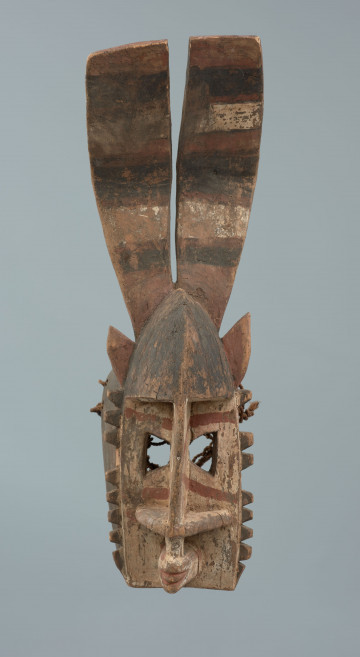
Gomintogo mask
między 1951 — 2000
National Museum in Szczecin
Part of the collection: Collection of Dogonian art
The adagaye mask, sometimes also called sa ku , i.e. head of the sa or azagay, refers to the Dogon cosmogonic myth and the battle between the creator god Amma and his rebellious son Yurugu. After creating the universe, Amma handed over rulership of his creation to the deity Nommo. Unfortunately, the order established in Heaven and Earth, which Nommo was supposed to watch over, was seriously threatened, and for one day stopped working at all. The perpetrator of that was Yurugu, a pale fox who always opposed Amma's actions and decisions. Yurugu took advantage of the fact that Amma had withdrawn from ruling the world and tried to take it over. He made all creatures believe that the Creator was dead. To legitimise his lie, he decided to give him a funeral. He consumed beer that he had prepared himself and danced on the terrace of his father's house. Then he began to make a mask from the bark of the sa tree (Lannea acida), which is an earthly symbol of the sacrifice made to Nommo and his re-birth. The pale fox thus wanted to seize the glory of the water deity and demonstrate his superiority. He tore the bark, but found that the inside was red in colour, very much like blood. The colour immediately evoked Nommo's blood sacrifice and his sacrifice. It thwarted all plans of Yurugu, who fled, abandoning the mask. The next day, Nommo made the sa tree dance. To commemorate these events, the male members of the Awa society also make masks from the bark of the sa tree. Adagaye acts as a guard to keep order during the events of the Dama funeral rituals. He also makes sure that women and children do not see the masked figures. The Dogon believe that such a sight could bring misfortune not only directly to the woman or child watching the dancers, but also to the whole village.
Ewa Prądzyńska
Author / creator
Dimensions
cały obiekt: height: 109 cm, width: 27 cm
Object type
sculpture, mask
Creation time / dating
Creation / finding place
Identification number
Location / status

między 1951 — 2000
National Museum in Szczecin

między 1951 — 2000
National Museum in Szczecin

między 1951 — 1998
National Museum in Szczecin
DISCOVER this TOPIC
National Museum in Lublin
DISCOVER this PATH
Educational path